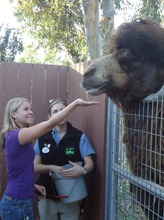Zoo InternQuest is a seven-week career exploration program for San Diego County high school juniors and seniors. Students have the unique opportunity to meet professionals working for the San Diego Zoo, Safari Park, and Institute for Conservation Research, learn about their jobs, and then blog about their experience online. Follow their adventures here!
 On our first week of Zoo InternQuest all of us were excited by the unknown. We sat in a secluded area of the Zoo and waited for the Zoo Educator, Kim Carroll. When Ms. Carroll came out to greet us she wasn?t alone. Along with her was Kizzy, a beautiful African grey parrot. She told us a bit of information about Kizzy and how her species is one of the most intelligent birds in the world. Unfortunately, like other parrots, African greys are threatened due to habitat loss and the pet trade.
On our first week of Zoo InternQuest all of us were excited by the unknown. We sat in a secluded area of the Zoo and waited for the Zoo Educator, Kim Carroll. When Ms. Carroll came out to greet us she wasn?t alone. Along with her was Kizzy, a beautiful African grey parrot. She told us a bit of information about Kizzy and how her species is one of the most intelligent birds in the world. Unfortunately, like other parrots, African greys are threatened due to habitat loss and the pet trade.
Before Kizzy came to the Zoo, she was kept as a pet. Birds can be very difficult to take care of. They are very vocal animals because in the wild that is their way of communicating with each other. When they become pets, they don?t lose that communication skill and, in turn, they can be very loud in an enclosed area such as a home. Also, birds can be very messy eaters because they have to crack open seeds in order to eat. This may seem like a hassle for a pet owner but, in the wild, birds do this and help spread seeds that can grow into trees and other plants. Another thing to consider if you or someone you know is thinking about getting a pet bird like Kizzy: a lot of birds can live to be fifty years old or more! So, if you get a bird at the age of ten, it can be your responsibility until you are about sixty years old. That?s a long time and a huge commitment to a pet.
Kizzy is now living at the Zoo and playing an important role as an Animal Ambassador. This means that Zoo Educators like Ms. Carroll take her to schools, hospitals and senior care facilities to educate people about wildlife and conservation. Growing Up Green, for example, is a program for children ages three to seven years old which introduces the concept of recycling. The Zoo leaves children with key messages, including the importance of conservation, awareness of endangered species and how each person can do little things to help save wildlife.
After the private session with the Animal Ambassadors, Ms. Carroll took us on an Inside Look Tour to update us on all the renovations at the San Diego Zoo. This tour is a perfect opportunity for guests to get up-close and personal with some of the animals. It?s also a perfect opportunity for the Zoo to show off its conservation side. For example, on one of the last stops of the tour we came to the Bactrian camel enclosure. Ms. Carroll pointed out how of part the enclosure was made from compressed recycled plastic that had been conformed into wooden-like fencing. Keepers have discovered their own way to walk the talk. When the Bactrian camels? thick winter coat sheds, it?s perfect for bird nesting material as well as enrichment- the smell helps trigger the hunting instincts of big cats. In the Bactrian camel enclosure we met Mongo, a massive male, who was very generous with his saliva while he was eating his celery treat.
We ended our tour at the giraffe enclosure where we got the opportunity to feed Silver, a male giraffe who towered over us with his long legs and neck. Silver?s long blackish-blue tongue wrapped around the acacia leaves and snatched the leaves from our hands. It was a perfect ending to a perfect day.
Kayla, Real World
Week One, Winter Session 2012
RELATED POSTS
Source: http://blogs.sandiegozoo.org/2012/02/21/zoo-educators-saving-the-animals-one-person-at-a-time/
the league the ides of march yankees espn magazine espn magazine anywhere but here wall street protesters
No comments:
Post a Comment
Note: Only a member of this blog may post a comment.